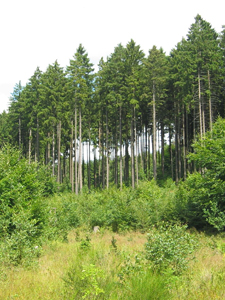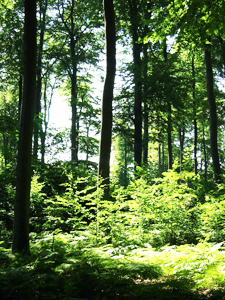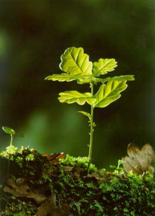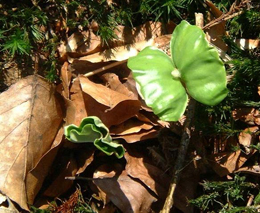In the 19th century, large parts of the Grünewald were bare as a consequence of an excessive exploitation, mainly due to the metallurgical site of Dommeldange and other metallurgical plants (around 1850) in the south of the country, needing huge quantities of firewood for the furnaces. Soon a serious lack of wood with threatening consequences came up and new regulations concerning the exploitation of timber had to be set up.
Timber forest

Timber forest structured by age
In order to stop the wild ravage, the Grünewald usage was regulated by the system of forest regeneration up from the second half of the 19th century. In the timber forest, trees of different ages did not grow together on the same site, but were separated according to their ages. Often trees were cut down by complete clearing and these surfaces were reforested later on by planting new ones. With the time snow, ice, insect and storm damages became more and more frequent and the complete clearing system weakened the vital strength of the forest considerably. There was absolutely no natural development and the damage of the storm Wiebke and Vivien in 1990 were fatal for those zones that had not been naturally constructed.
Permanent forest

Beech grove in multi layer structure with herb and bush layer
As a consequence it was decided that the timber forest system had to get replaced by the process of natural forest regeneration, leading to a permanent and natural composed forest. In such a forest human interventions are limited to a minimum in order to support to maximum the natural evolution of the forest for a proper usage. This system of forest exploitation allows having on one same surface trees of different ages, from the young sprouts to the coarse wood debris, offering a rich habitat for many animal and botanical species.
A strong and multilayer structured forest is much more resistant to bad weather conditions and offers many habitats for fauna and flora. The typical trees of this kind of forest in the region are: beech, oak, ash, maple, cherry tree, alder and birch.
In the Grünewald no chemical fertilizer are used either and the trees that have to get cut down are chosen individually. A new tree generation is born out of the young seedlings, growing on the ground level, perfectly protected by the crowns of the high stemmed upper layer trees (principle of the natural forest regeneration).
The permanent forest aims to deliver an excellent high quality timber, generated by a long lasting, naturally growing and protective forest.
 In the timber forest, trees of different ages do not grow together on the same site, but are separated according to their ages. Trees are cut down by complete clearing and these large surfaces are reforested later on by planting new ones with only one or a few different species, generating monotonous surfaces of one same age. |
 In the permanent forest all age categories are represented on a minimum surface. When single trees are cut down clearings that allow the light to penetrate to the ground level (light shaft) are formed and generate new plants and trees finding perfect vital conditions. |
 Oak seedling |
 Beech seedling |
